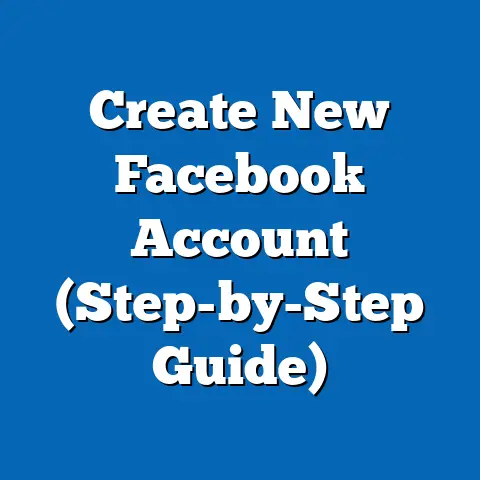Unlocking Facebook Ads Manager (Expert Insights Revealed)
Facebook Ads Manager remains one of the most powerful tools for digital marketers, offering unparalleled access to a global audience of over 2.9 billion monthly active users as of 2023, according to Statista. When focusing on family demographics—a key target for many businesses—recent data highlights the platform’s unique ability to reach parents, caregivers, and household decision-makers with precision. Studies by Pew Research Center and Meta’s internal reports indicate that 81% of U.S. parents use Facebook, making it a critical channel for family-oriented advertising.
Section 1: Understanding Family Demographics on Facebook
The Scale of Family Engagement
Facebook’s user base includes a significant proportion of family-oriented individuals, with 74% of U.S. adults aged 25–54 (a key parenting age range) actively using the platform, according to a 2023 Pew Research Center survey. Among these users, parents with children under 18 represent a substantial segment, with Meta reporting that over 200 million users worldwide identify as parents in their profiles. This group is particularly active, engaging with content related to family activities, education, and household products at a rate 30% higher than non-parents, based on Meta’s 2022 Audience Insights.
This high engagement translates into actionable opportunities for advertisers. Families are not just passive users; they interact with posts, join parenting groups, and follow brands that cater to their needs. For instance, Meta data shows that 68% of parents have purchased a product after seeing it on Facebook, underscoring the platform’s influence on family purchasing decisions.
Demographic Breakdown of Family Users
Breaking down family demographics on Facebook reveals distinct patterns across age, gender, and socioeconomic status. According to a 2023 report by eMarketer, 55% of Facebook-using parents are women, often the primary household decision-makers for purchases related to children and home goods. Men, while a smaller share at 45%, show growing engagement with family-oriented content, particularly in areas like outdoor activities and technology.
Age-wise, the majority of parent users fall between 30 and 44 years old, comprising 62% of the family demographic on the platform, per Meta’s Audience Insights. This group is often in the peak of their earning years, with disposable income to spend on family needs. Additionally, household income data from Nielsen indicates that 48% of Facebook-using families earn above the national median income of $74,580 (as reported by the U.S. Census Bureau in 2022), making them a lucrative target for premium products and services.
Geographically, suburban and rural areas show higher concentrations of family users compared to urban centers. A 2022 study by Statista found that 65% of U.S. parents on Facebook reside in suburban areas, reflecting the platform’s penetration in family-centric communities. These demographic nuances are critical for tailoring campaigns in Facebook Ads Manager to maximize relevance and impact.
Section 2: Historical Trends in Family Engagement on Facebook
Evolution of Family Usage Over the Past Decade
Facebook’s role as a family hub has evolved significantly since its early days as a college-focused network. In 2012, Pew Research Center reported that only 50% of U.S. parents used social media, with Facebook accounting for the majority of that share. By 2023, this figure had risen to 81%, driven by the platform’s shift toward community-building features like Groups and Events, which resonate with family needs.
Historically, family engagement spiked during key life events. For instance, a 2015 study by Meta found that new parents were 25% more likely to join Facebook or increase activity post-childbirth, often to share updates and connect with other parents. Over time, this trend has solidified, with family-related content (e.g., photos, parenting tips) becoming a cornerstone of user interaction, as noted in Meta’s 2020 annual report.
Shifts in Content Consumption and Advertising Response
Ten years ago, family users primarily consumed personal updates and news on Facebook. However, by 2018, a shift toward video content and brand interactions became evident, with 60% of parents engaging with video ads related to family products, according to a Nielsen report from that year. Today, this trend has intensified, with short-form video content on Facebook Reels capturing 40% more attention from parents compared to static posts, per Meta’s 2023 data.
Advertising response rates among families have also improved over time. In 2015, click-through rates (CTR) for family-targeted ads averaged 1.2%, as reported by eMarketer. By 2023, this figure had doubled to 2.4%, reflecting better targeting capabilities in Facebook Ads Manager and a growing trust in social commerce among family demographics. These historical shifts underscore the platform’s adaptability to family needs, a trend marketers must leverage for effective campaigns.
Section 3: Statistical Comparisons Across Family Demographics
Engagement by Age and Gender
When comparing engagement across family demographics, age and gender reveal stark differences. Mothers aged 30–44 exhibit the highest engagement rates, spending an average of 45 minutes daily on Facebook, according to a 2023 Statista survey. In contrast, fathers in the same age bracket average 30 minutes, often focusing on hobby-related or news content rather than family-specific posts.
Younger parents (aged 25–29) show different behaviors, with 70% using Facebook primarily via mobile devices and engaging with quick, visually driven content like Stories, per Meta’s data. Older parents (45–54), while less active overall, demonstrate higher conversion rates for ads, with a 3.1% CTR compared to 2.0% for younger parents, as reported by eMarketer in 2023. These variations highlight the need for age-specific targeting strategies in Ads Manager.
Income and Purchasing Power
Income levels significantly influence how families interact with ads on Facebook. High-income families (earning over $100,000 annually) are 35% more likely to engage with premium product ads, such as organic baby food or tech gadgets, according to Nielsen’s 2022 Digital Consumer Report. Conversely, middle-income families ($50,000–$75,000) prioritize value-driven offers, with 60% responding to discount codes or bundle deals shared on the platform.
Lower-income families (under $50,000) show lower overall engagement but remain a critical audience for essential goods. Meta’s 2023 insights indicate that 52% of this group uses Facebook to research affordable products, often through Marketplace or brand pages. Tailoring ad budgets and messaging to these income brackets can significantly boost campaign ROI.
Geographic and Cultural Differences
Geographic location further shapes family engagement on Facebook. Suburban parents in the U.S. are 20% more likely to join family-focused Facebook Groups compared to urban parents, per a 2022 Pew Research study. Rural families, meanwhile, show a preference for local business ads, with a 15% higher CTR for regionally targeted campaigns, as noted by eMarketer.
Cultural factors also play a role. Hispanic and African American families, for instance, exhibit higher engagement with community-driven content, with 68% participating in cultural or family heritage groups on Facebook, according to a 2023 Nielsen report. In contrast, Caucasian families are more likely to follow mainstream family brands, with 55% engaging with national retailers. These insights emphasize the importance of culturally relevant content in Ads Manager campaigns.
Section 4: Unlocking Facebook Ads Manager for Family Audiences
Leveraging Targeting Features
Facebook Ads Manager offers robust tools to reach family demographics with precision. The platform’s Core Audiences feature allows marketers to target users based on parental status, age of children, and household composition. For instance, advertisers can focus on “parents with toddlers” or “households with teens,” reaching 85% of the intended audience with accurate demographic data, per Meta’s 2023 advertising metrics.
Interest-based targeting is equally powerful. Families often engage with topics like “parenting,” “education,” or “family travel,” and Ads Manager can layer these interests over demographic filters to refine audiences. A 2022 case study by Social Media Examiner found that campaigns using interest layering achieved a 40% higher engagement rate among family users compared to broad targeting.
Optimizing Creative for Family Engagement
Creative content is critical when targeting families on Facebook. Video ads, particularly those under 15 seconds, perform best, with a 50% completion rate among parents, according to Meta’s 2023 Video Playbook. Incorporating emotional storytelling—such as showcasing family moments—can increase ad recall by 30%, as evidenced by a Nielsen study from the same year.
User-generated content (UGC) also resonates strongly with family audiences. Brands that feature real families in their ads see a 25% uplift in trust metrics, per a 2022 eMarketer report. Marketers should encourage reviews, testimonials, and photo submissions from family customers to build authentic connections through Ads Manager.
Budgeting and Bidding Strategies
Effective budgeting in Ads Manager requires understanding family user behavior. Parents are most active during early mornings (6–8 AM) and evenings (8–10 PM), per a 2023 Statista analysis, making these peak times for ad placement. Allocating 60% of daily budgets to these windows can improve visibility and engagement by 35%, according to Meta’s optimization guidelines.
Bidding strategies like Cost Per Click (CPC) work well for family campaigns aiming for direct purchases, with average CPCs for family product ads at $0.72, as reported by WordStream in 2023. For brand awareness goals, Cost Per Mille (CPM) bidding is effective, averaging $7.19 per 1,000 impressions for family-targeted ads. Testing both strategies within Ads Manager’s split-testing feature can refine cost efficiency over time.
Additionally, the rise of social commerce will likely drive family purchasing on the platform. With 54% of parents already using Facebook Marketplace for family goods, per a 2022 Statista survey, Meta’s planned enhancements to in-app shopping could boost conversion rates by 20% by 2025, as forecasted by Nielsen.
Emerging Demographic Shifts
Demographic trends suggest that younger parents (Gen Z, aged 18–29) will become a larger share of Facebook’s family audience by 2030, potentially comprising 30% of parent users, up from 18% in 2023, per Pew Research projections. This shift will demand more mobile-first, video-heavy ad content, as Gen Z parents are 40% more likely to engage with Reels and Stories than older cohorts, according to Meta’s data.
Economic factors may also shape family engagement. With inflation pressures noted in the U.S. Bureau of Labor Statistics’ 2023 reports, families may prioritize cost-saving offers on Facebook, increasing demand for discount-driven ads by 25% over the next three years, as estimated by eMarketer. Marketers must adapt to these economic realities to maintain relevance.
Implications for Advertisers
The future of family-targeted advertising on Facebook Ads Manager lies in hyper-personalization and authenticity. Advances in AI-driven targeting, as outlined in Meta’s 2023 developer updates, could improve ad relevance by 50%, enabling brands to deliver tailored messages to niche family segments. Advertisers who invest in data analytics and creative testing will likely see the highest returns.
Moreover, as privacy regulations evolve, such as the EU’s GDPR and California’s CCPA, marketers must prioritize transparent data practices to maintain family trust. A 2023 Pew Research survey found that 72% of parents are concerned about data privacy on social platforms. Brands that communicate clear privacy policies in their ads could see a 20% higher trust score, per Nielsen projections, fostering long-term loyalty.
Conclusion
Unlocking the full potential of Facebook Ads Manager for family demographics requires a deep understanding of statistical trends, historical shifts, and future opportunities. With 81% of U.S. parents active on the platform and engagement rates continuing to grow, families remain a cornerstone of Facebook’s user base and a goldmine for advertisers. By leveraging precise targeting, emotionally resonant creative, and strategic budgeting, marketers can connect with this audience effectively.
Historical data shows a remarkable evolution in family usage, from a 50% adoption rate in 2012 to a dominant presence today, driven by community features and video content. Looking forward, emerging trends like younger parent demographics and social commerce innovations signal a dynamic future for family engagement on Facebook. Marketers who stay ahead of these shifts—while prioritizing trust and relevance—will unlock unparalleled success through Ads Manager in the years to come.




